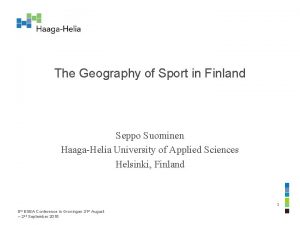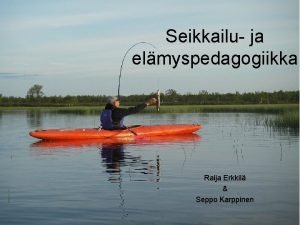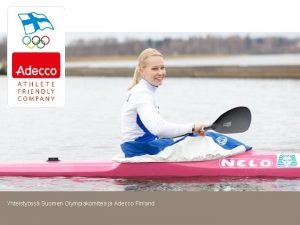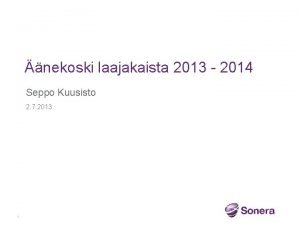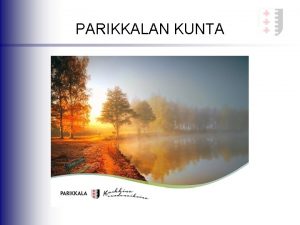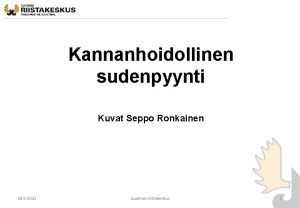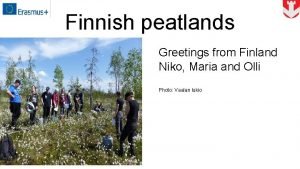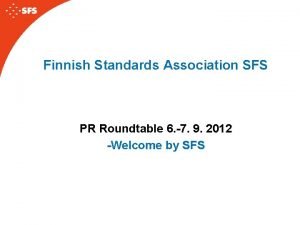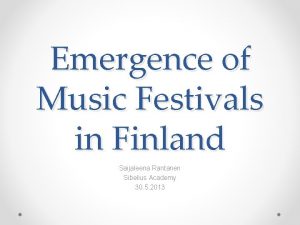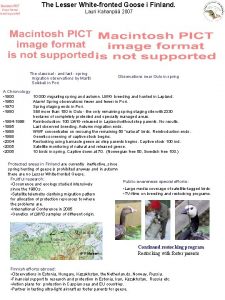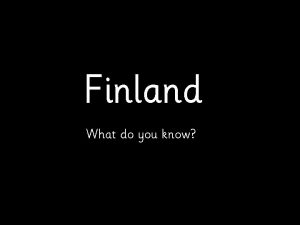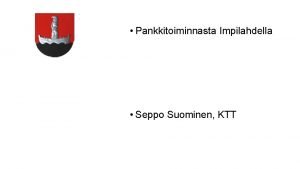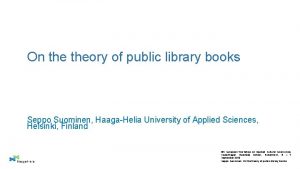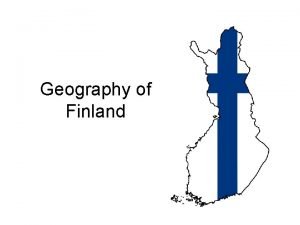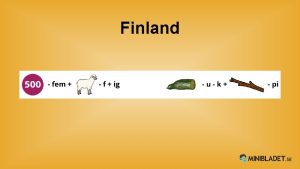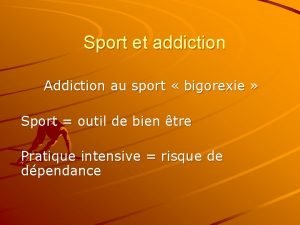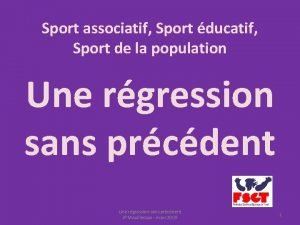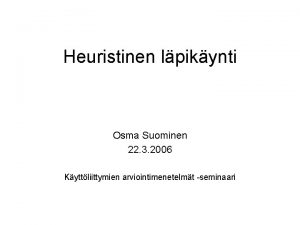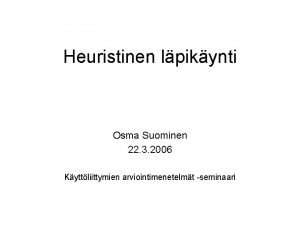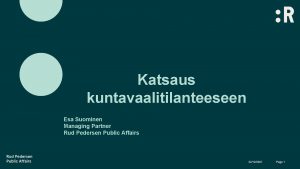The Geography of Sport in Finland Seppo Suominen





























- Slides: 29

The Geography of Sport in Finland Seppo Suominen Haaga-Helia University of Applied Sciences Helsinki, Finland 1 8 th ESEA Conference in Groningen 31 st August – 2 nd September 2016

The Geography of Sport in Finland § § § Introduction Relevant literature A model Data and prescriptive statistics Empirical results Conclusions 8 th ESEA Conference in Groningen 31 st August – 2 nd September 2016 2 Seppo Suominen The Geography of Sport in Finland

Introduction § The sports geography shows that in Finland the most of the men’s ice hockey or floorball top league teams are located in large cities while a more traditional baseball in Finland is more rural. § During a rather long period from 1990 to 2015 men’s ice hockey has been played in 15 different cities. § Other popular team sports leagues have not been closed during the sample period but still the geography shows that the locations have been rather stable. 8 th ESEA Conference in Groningen 31 st August – 2 nd September 2016 3 Seppo Suominen The Geography of Sport in Finland

Introduction Regular number of teams in highest league Different teams Different towns HHI (towns) Pop 2005, min Pop 2005, 25 % Pop median 2005, Pop 2005, 75 % Pop 2005, max Ice Football, Baseball, Floorball, Volleyball, Basketbal hockey, # # 327 # 337 # 328 # 282 l, # 323 340 12 - 15 10 – 14 11 – 15 10 - 14 8 – 12 10 – 16 18 15 935 31190 59017 122720 33 23 719 10716 22233 76191 28 27 519 3414 9886 21885 46 23 1124 7413 57085 174984 33 24 640 3834 14035 24243 27 21 610 7844 18083 54802 174984 560905 127337 560905 37374 560905 203029 560905 57617 560905 174984 560905 8 th ESEA Conference in Groningen 31 st August – 2 nd September 2016 4 Seppo Suominen The Geography of Sport in

Introduction § 8 th ESEA Conference in Groningen 31 st August – 2 nd September 2016 5 Seppo Suominen The Geography of Sport in

Introduction § § The stability of team locations raises some questions: Why teams survive in some locations, How many top teams a particular town can sustain, How differentiated these towns are in terms of different sport types. 8 th ESEA Conference in Groningen 31 st August – 2 nd September 2016 6 Seppo Suominen The Geography of Sport in

Relevant literature § Using NHL data Jones and Ferguson (1988) show that the major attributes that have an impact on the chances of franchise survival are population and location in Canada. § The locational quality is the key element in teams’ revenue determination. § Coates and Humphreys (1997) show that sports environment and real income growth are negatively interrelated. § Chapin (2000) and Newsome and Comer (2000) emphasise that since the Second World War sport facilities or venue were built in suburban locations but not in city centres § however, since 1980’s most of the new professional sport venues have been located in central city areas although these locations are rather expensive to acquire. § Oberhofer, Philippovich and Winner (2015) show using German football data that financial resources have a positive impact on survival in the highest league (Bundesliga) while the local market size measured by population has a low but st August 8 th ESEA Conference in Groningen 31 negative effect on survival. nd – 2 September 2016 7 Seppo Suominen The Geography of Sport in

A model § 8 th ESEA Conference in Groningen 31 st August – 2 nd September 2016 8 Seppo Suominen The Geography of Sport in

A model § 8 th ESEA Conference in Groningen 31 st August – 2 nd September 2016 9 Seppo Suominen The Geography of Sport in Finland

A model § 8 th ESEA Conference in Groningen 31 st August – 2 nd September 2016 10 Seppo Suominen The Geography of Sport in

A model § 8 th ESEA Conference in Groningen 31 st August – 2 nd September 2016 11 Seppo Suominen The Geography of Sport in

A model § 8 th ESEA Conference in Groningen 31 st August – 2 nd September 2016 12 Seppo Suominen The Geography of Sport in

A model § 8 th ESEA Conference in Groningen 31 st August – 2 nd September 2016 13 Seppo Suominen The Geography of Sport in

A model § H 1: If the town is small in terms of population (L), the variety of sports offered in a town is small (N). § H 2: When the fixed costs (F) due to nature of the sports are high, the variety of sports offered in a town is low (N). § H 3: The number of spectators (qi) is more correlated with fixed costs (F) than with population (L). 8 th ESEA Conference in Groningen 31 st August – 2 nd September 2016 14 Seppo Suominen The Geography of Sport in

Data and prescriptive statistics § Data on the number of top sport teams in a town is typically count data. We have in the data some towns that have had during the 1990 – 2015 period only once a top team and the corresponding figure in Helsinki is 215. § Men: Ice hockey, Football, Baseball (not American style!), Floorball, Volleyball, Basketball. 8 th ESEA Conference in Groningen 31 st August – 2 nd September 2016 15 Seppo Suominen The Geography of Sport in

Sports geography blue Football black Ice hockey orange Basketball red Volleyball yellow Baseball white Floorball

Sports geography blue Football black Ice hockey orange Basketball red Volleyball yellow Baseball white Floorball

Sports geography blue Football black Ice hockey orange Basketball red Volleyball yellow Baseball white Floorball

Sports geography blue Football black Ice hockey orange Basketball red Volleyball yellow Baseball white Floorball

Sports geography blue Football black Ice hockey orange Basketball red Volleyball yellow Baseball white Floorball

Sports geography blue Football black Ice hockey orange Basketball red Volleyball yellow Baseball white Floorball

Sports geography blue Football black Ice hockey orange Basketball red Volleyball yellow Baseball white Floorball

Sports geography blue Football black Ice hockey orange Basketball red Volleyball yellow Baseball white Floorball

Sports Geography All blue Football black Ice hockey orange Basketball red Volleyball yellow Baseball white Floorball

Empirical results § § § There are two commonly used estimation methods for count data: Poisson regression and Negative Binomial regression. The yi variable is the aggregate number of teams in the highest league of these six sports from 1990 to 2015. Bigger towns naturally have the highest score: Helsinki has 214 (population in 2005 was 560905), Espoo 83 (231704), Tampere 176 (204337), Vantaa 41 (187281), Turku 92 (174868), Oulu 72 (173436) and Jyväskylä 97 (124205). Espoo and Vantaa are the neighbouring cities of Helsinki and it seems that Helsinki is cannibalising their score The Dixit-Stiglitz model equilibrium proposes that the score (N) is related to labour (incomes so that wage is equalised to one), hence a relevant xi variable takes into account both (the logarithm of) the population (2005) and personal incomes (2007) 8 th ESEA Conference in Groningen 31 st August – 2 nd September 2016 25 Seppo Suominen The Geography of Sport in

Empirical results yi = Score Log Population Dummy: Population < 15000 Dummy: 15000 < Population < 30000 Dummy: 30000 < Population < 50000 Dummy: 50000 < Population < 100000 Dummy: 100000 < Population < 200000 Dummy: 200000 < Population Log Incomes Constant α Poisson 0. 924 (0. 023)*** Negative Binomial 0. 749 (0. 092)*** Poisson Negative Binomial -0. 318 (0. 135)* -0. 848 (0. 256)*** 0. 128 (0. 128) -0. 504 (0. 256)* ref 1. 207 (0. 121)*** 1. 068 (0. 355)** 1. 809 (0. 122)*** 1. 226 (0. 530)** 2. 883 (0. 120)*** -2. 291 (0. 259)*** 25. 796 (2. 655)*** 0. 719 2. 270 (0. 603)*** -2. 268 (0. 709)** 25. 956 (7. 288)*** 0. 324 (0. 074)*** 0. 269 309. 444 *** 1810. 004 *** 5. 804 190. 838 *** 2. 984 -2. 417 (0. 245)*** 17. 982 (2. 500)*** -2. 118 (0. 851)* 16. 814 (8. 435)* 0. 503 (0. 116)*** 0. 370 Mc. Fadden 0. 668 Pseudo R 2 χ2 1682. 164 *** Overdispersion 3. 669 tests: g = μi st August 8 th ESEA Conference in Groningen 31 Overdispersion 1. 856 – 2 nd September 2016 tests: g = μi 2 26 Seppo Suominen The Geography of Sport in

Empirical results § The Poisson and Negative Binomial regression results show that the score is positively related to town size and negatively to incomes. It seems that sports is not favoured by high income consumers. § H 3: The number of spectators (qi) is more correlated with fixed costs (F) than with population (L). Budget Population Spectators Budget 1 0. 331 0. 958 Population 1 0. 389 Spectators 1 8 th ESEA Conference in Groningen 31 st August – 2 nd September 2016 27 Seppo Suominen The Geography of Sport in

Conclusions § A larger town in terms of population is able to sustain a bigger number of teams and also a larger variation of sports. § Somewhat surprisingly towns with lower incomes are on average able to sustain a bigger number of different teams. § The location decisions of top teams: They seem to have less survival possibilities in high income towns than in low income towns and regions. § The Dixit-Stiglitz model also proposes that the attendance or the number of spectators is more related and correlated with the cost structure of the team than with the population statistics. The results seem to verify this hypothesis. 8 th ESEA Conference in Groningen 31 st August – 2 nd September 2016 28 Seppo Suominen The Geography of Sport in

Thank you for your attention 29 8 th ESEA Conference in Groningen 31 st August – 2 nd September 2016 Seppo Suominen The Geography of Sport in
 Seppo suominen
Seppo suominen Seppo suominen
Seppo suominen Haaga helia malmi
Haaga helia malmi Esa suominen
Esa suominen Arto osma
Arto osma Sosiokulttuuriset tekijät
Sosiokulttuuriset tekijät Seikkailukasvatus ja elämyspedagogiikka
Seikkailukasvatus ja elämyspedagogiikka Seppo seunavaara
Seppo seunavaara Lentisliiga
Lentisliiga Seppo mylläri
Seppo mylläri Parikkalan kunnanvaltuusto
Parikkalan kunnanvaltuusto Seppo ronkainen susi
Seppo ronkainen susi Ytv 2012
Ytv 2012 Cpap nenämaski
Cpap nenämaski Aqua finland
Aqua finland Interflora finland helsinki
Interflora finland helsinki Greetings from finland
Greetings from finland Special education in finland
Special education in finland Finnish standards association
Finnish standards association Music festivals finland
Music festivals finland National board of education finland
National board of education finland Oats from finland
Oats from finland Nestball finland
Nestball finland Finnair checkin
Finnair checkin Belgium mothers day
Belgium mothers day Biocenter finland
Biocenter finland Finland quality design
Finland quality design Technology industries of finland
Technology industries of finland Dhl galati
Dhl galati Finland goose
Finland goose
